The Factorial ANOVA (with two mixed factors) is kind of like combination of a One-Way ANOVA and a Repeated-Measures ANOVA.
Here's an example of a Factorial ANOVA question:
Researchers want to see if high school students and college students have different levels of anxiety as they progress through the semester. They measure the anxiety of 12 participants three times: Week 1, Week 2, and Week 3. Participants are either high school students, or college students. Anxiety is rated on a scale of 1-10, with 10 being “high anxiety” and 1 being “low anxiety”. Use alpha = 0.05 to conduct your analysis.
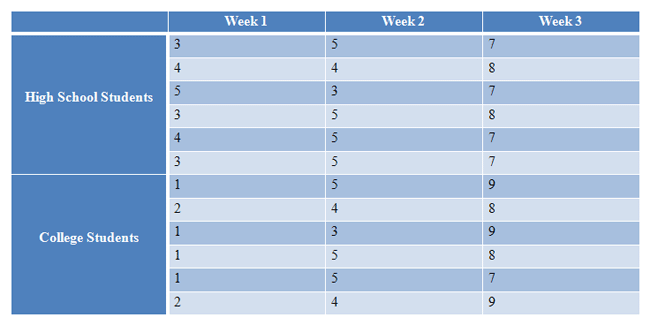
|
Figure 1. |
|---|
This is a Mixed ANOVA because "school" is independent while "week" is dependent.
Let's try a full example:
| Steps for Factorial ANOVA, Two Mixed Factors |
|---|
|
1. Define Null and Alternative Hypotheses 2. State Alpha 3. Calculate Degrees of Freedom 4. State Decision Rule 5. Calculate Test Statistic 6. State Results 7. State Conclusion |
1. Define Null and Alternative Hypotheses
Here, we have three. One for each main effect, and one for the interaction.

|
Figure 2. |
|---|
2. State Alpha
alpha = 0.05
3. Calculate Degrees of Freedom
Before we start calculating our degrees of freedom, let's look at our source table:
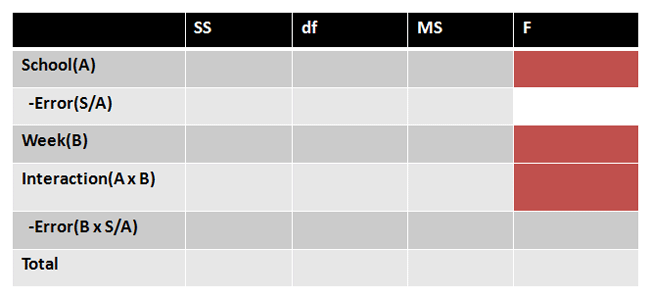
|
Figure 3. |
|---|
Here we have 6 SS. 3 are associated with each of our effects. There are also two separate error terms: one for effects that only contain variables that are independent, and one for effects that contain variables that are dependent. And finally, we have SS total. We will need to find all of these things to calculate our three F statistics.
Degrees of freedom are calculated as follows. "a" is the number of a groups you have, "b" is the number of b groups you have, "n" (sometimes called "s") is the total number of scores in each cell, and "N" is your total number of scores.
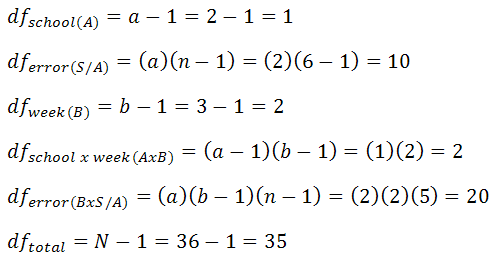
|
Figure 4. |
|---|
4. State Decision Rule
We have three hypotheses, so we have three decision rules. Critical values are found using the effect and error degrees of freedom for our three effects:

|
Figure 5. |
|---|
We now head to the F-table and look up our critical values using alpha = 0.05. In the table, we find the critical values shown below:

|
Figure 6. |
|---|
These critical values bring us to our three decision rules:
[School] If F is greater than 4.35, reject the null hypothesis.
[Week] If F is greater than 3.49, reject the null hypothesis.
[Interaction] If F is greater than 3.49, reject the null hypothesis.
5. Calculate Test Statistic
First, we'll put the degrees of freedom that we've already calculated into our source table:
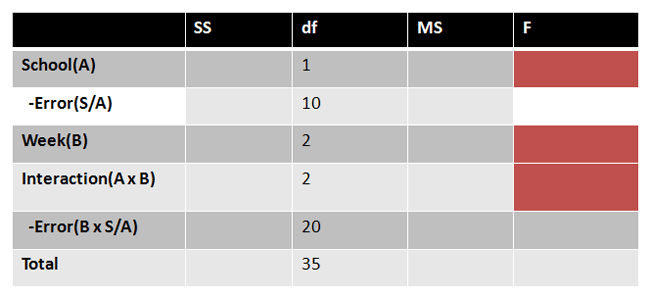
|
Figure 7. |
|---|
Next, we need to find the six SS values we are missing:

|
Figure 8. |
|---|
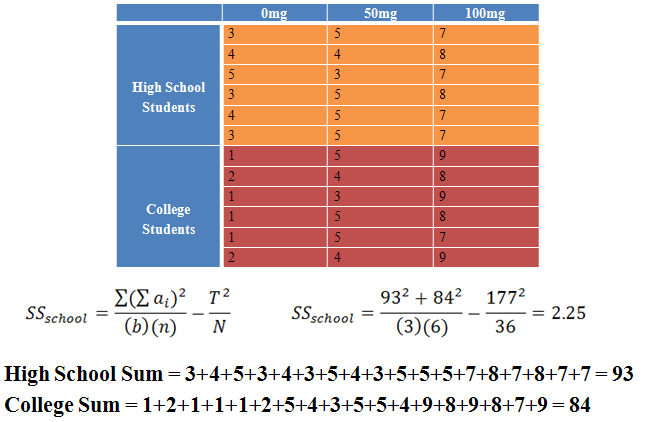
|
Figure 9. |
|---|
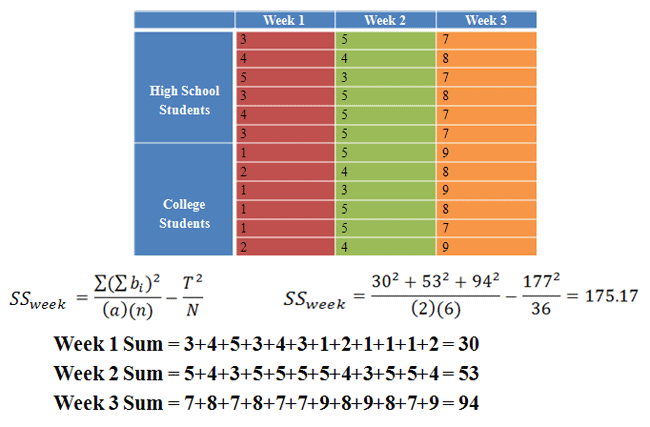
|
Figure 10. |
|---|
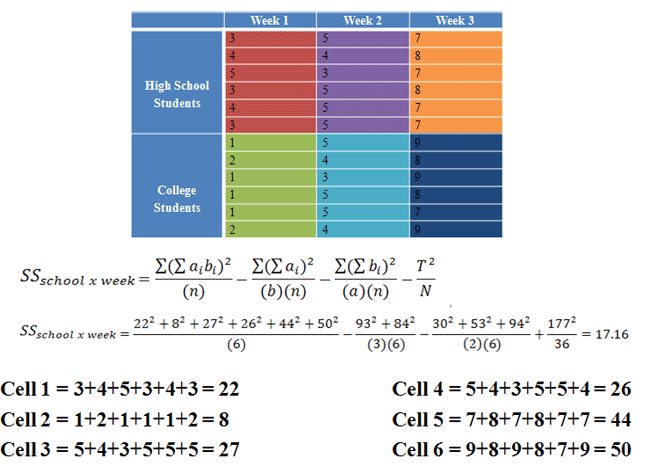
|
Figure 11. |
|---|

|
Figure 12. |
|---|
These SS values are then placed into our source table.
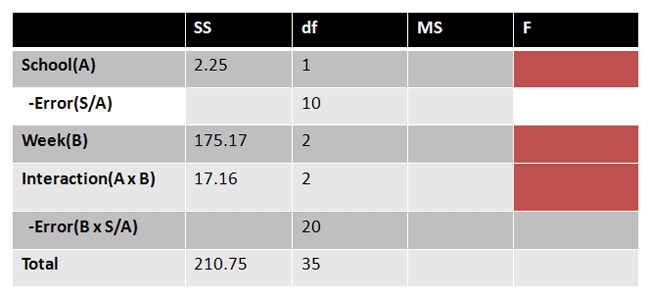
|
Figure 13. |
|---|
Now, we calculate one of our error terms.
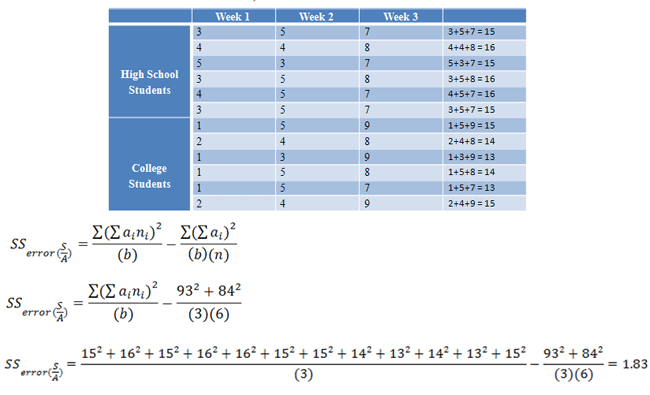
|
Figure 14. |
|---|
We then place all of our values into the source table. We find the last missing value, B x S/A, by subtracting every value we've found so far from the total.
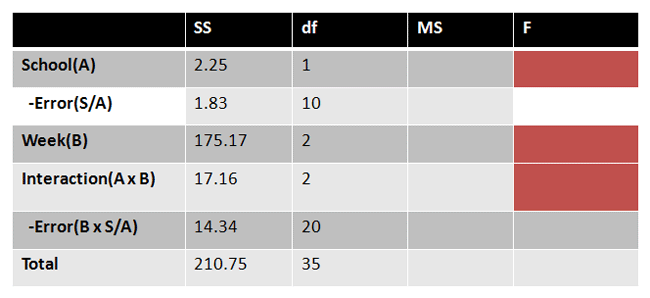
|
Figure 15. |
|---|
Each MS value is found by dividing each SS by their respective degrees of freedom:
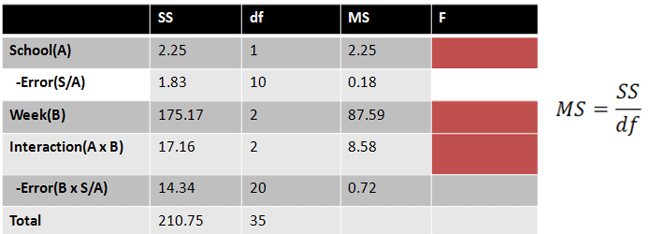
|
Figure 16. |
|---|
Finally, our three F values are found:

|
Figure 17. |
|---|
6. State Results
[School] If F is greater than 4.35, reject the null hypothesis.
Our F = 12.5. Reject the null hypothesis.
[Week] If F is greater than 3.49, reject the null hypothesis.
Our F = 121.65. Reject the null hypothesis.
[Interaction] If F is greater than 3.49, reject the null hypothesis.
Our F = 11.92. Reject the null hypothesis.
7. State Conclusion
High school students and college students had significantly different anxiety levels, F(1, 10) = 12.5, p < 0.05. There was a significant difference between the three different weeks, F(2, 20) = 121.65, p < 0.05. An interaction effect was also present, F(2, 20) = 11.92, p < 0.05.